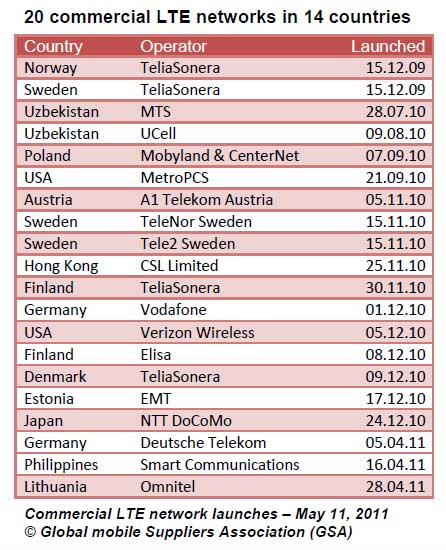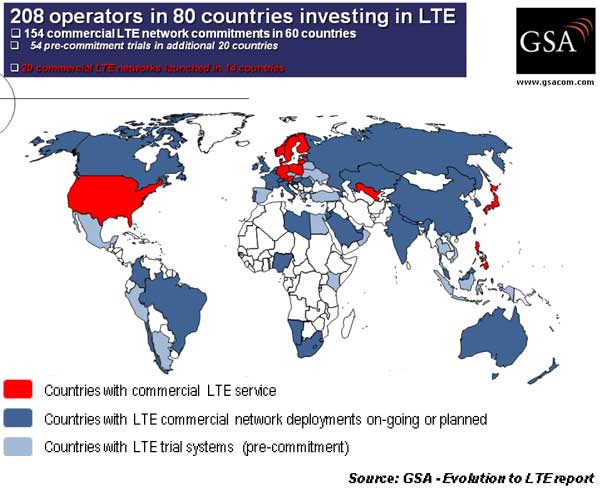The 3GPP LTE system delivers capacity and data throughput enhancements and low latency, to support new services and features requiring higher levels of capability and performance. LTE is the next step in the user experience, enhancing more demanding applications such as interactive TV, mobile video blogging, advanced gaming, and professional services. This report from the Global mobile Suppliers Association (GSA) tracks the evolution to LTE.
June 15, 2011

The 3GPP LTE system delivers capacity and data throughput enhancements and low latency, to support new services and features requiring higher levels of capability and performance. LTE is the next step in the user experience, enhancing more demanding applications such as interactive TV, mobile video blogging, advanced gaming, and professional services. This report from the Global mobile Suppliers Association (GSA) tracks the evolution to LTE.
Data rates are significantly higher. LTE supports a full IP-based network and harmonization with other radio access technologies. LTE reduces the cost per Gigabyte of data delivered, which is essential to address the mass market. LTE standardization covers FDD and TDD modes. Infrastructure solutions offer an easy upgrade path to LTE. The HSPA and HSPA+ mobile broadband ecosystem is mainstream and LTE is the natural migration choice for GSM/HSPA network operators.
CDMA operators and, increasingly, WiMAX operators are also deciding to evolve to LTE as the clear mobile broadband system of choice.

commercial-lte
Spectrum for LTE deployments
LTE can be deployed in existing 2G or 3G bands, and in new spectrum such as 2.6 GHz now being allocated in many regions, and the 700 MHz band released as part of the Digital Dividend, starting in the USA. Initial deployments in Japan use 800 MHz, 1.5 GHz and 1.7 GHz (operator-dependant). There is strong demand in Europe and elsewhere to access new spectrum from the Digital Dividend (800 MHz), which enables LTE to be deployed more efficiently over large geographical areas, and improve in-building coverage. There is also high interest in using re-farmed spectrum LTE, e.g. 900, 1800 MHz bands as regulators adopt a technology-neutral approach.
Design targets for LTE include:
Instantaneous downlink peak data rate of at least 100 Mb/s within 20 MHz allocation (5 bps/Hz)
Instantaneous uplink peak data rate of 50 Mb/s (2.5 bps/Hz within a 20MHz uplink allocation)
Downlink: average user throughput per MHz, 3 to 4 times Release 6 HSDPA
Uplink: average user throughput per MHz, 2-3 times Release 6 Enhanced Uplink
E-UTRAN optimized for low mobile speed: 0-15 km/h. Higher mobile speed between 15-120 km/h should be supported with high performance. Mobility across the cellular network shall be maintained at speeds 120 km/h-350 km/h (or even up to 500 km/h depending on the frequency band)
Spectrum flexibility: scalable to operate in 1.4, 2.5, 5, 10, 15 and 20 MHz allocations: Uplink and downlink…paired and unpaired
Co-existence with GERAN/3G on adjacent channels; with other operators on adjacent channels; overlapping or adjacent spectrum at country borders; handover with UTRAN & GERAN LTE radio network products incorporate several features to simplify building and management of next-generation networks. Plug-and-play, self-configuration and self-optimization simplify and reduce network rollout and management cost. LTE will be deployed alongside simplified, IP-based core and transport networks that are easier to build, maintain and introduce services on. The 3GPP core network has also undergone System Architecture Evolution (SAE), optimized for packet mode and in particular for the IP-Multimedia Subsystem (IMS) to support all access technologies, including fixed wire-line access. This allows:
Improvements in latency, capacity, throughput
Simplification of the core network, and optimization for IP traffic and services, and expected growth
Simplified support and handover to non-3GPP access technologies The result is the evolved packet system (EPS) that consists of the core network part, the evolved packet core (EPC) and the radio network evolution part, the evolved UTRAN (E-UTRAN), i.e. LTE. The EPS is also standardized within 3GPP Release 8.
LTE TDD Systems
Most LTE commitments and deployments use the paired spectrum (FDD) mode. The LTE TDD mode for unpaired spectrum is complementary and valuable in several markets. LTE TDD also provides a future-proof evolutionary path for TD-SCDMA, another 3GPP standard, which is widely deployed in China.
LTE TDD is the perfect choice for providing high speed mobile broadband access in unpaired spectrum. It is an integral part of the 3GPP standards implementing a maximum of commonalities with LTE FDD and offering comparable performance characteristics with similarly high spectral efficiency.
Within the globally assigned IMT bands for mobile (broadband) communication, significant spectrum resources are suitable for LTE TDD. The largest contiguous bands are at 2.3 GHz (100 MHz) and within the 2.6 GHz band (e.g. 50 MHz according to the CEPT band plan). Due to the recognized demand for radio technologies for unpaired bands and based on the commonalities as explained above, LTE TDD can exploit global economies of scale similar to LTE FDD, with a short time to market.
It is likely that LTE TDD will become a globally accepted technology, and provide an excellent evolution path for TD-SCDMA and WiMAX networks.
The growing number of LTE TDD operator commitments, system maturity, and the expanding eco-system are detailed later in this report.
LTE-Advanced Systems
LTE FDD and LTE TDD have a clear evolution towards LTE-Advanced which includes many features originally considered for the future ITU IMT-Advanced system.
LTE global round-up:
In October 2010 the ITU accepted and officially designated LTE-Advanced as an IMT-Advanced (4G) technology.
IMT-Advanced provides a global platform on which to build the next-generations of interactive mobile services that will provide faster data access, enhanced roaming capabilities, unified messaging and broadband multimedia.
A number of LTE-Advanced test systems are operating or planned around the world, and several demonstrations were given at MWC 2011. NTT DoCoMo is undertaking field experiments of LTEAdvanced in real radio environments in the cities of Yokosuka and Sagamihara. NTT DoCoMo has already confirmed the performance of LTE-Advanced technologies using simulators in its R & D center, achieving transmission data rates of approximately 1 Gbps on the downlink and 200 Mbps on the uplink.
The Korea Communications Commission and the Korean Ministry of Knowledge Economy have held a demonstration of an LTE-Advanced system, which featured ‘evolved Multimedia Broadcast and Multicast Service’ indoors and an in-vehicle demonstration outdoors demonstrating 3D full HD broadcasting and HD video calling.
3GPP has published Release 10 of the standard (at the March 2011 Plenary meetings) and formally frozen the set of features for LTE-Advanced. The completion of Release 10 is the final step in the four year process to ensure that the 3GPP radio interface will meet the formal requirements of IMT-Advanced. As is the case with current work on HSPA Evolution (HSPA+), LTE work will continue beyond the current Release. It is a well proven method in 3GPP that work is allowed to carry on, but is punctuated by a series of Releases, allowing the industry to make products and plan services from that point on. 3GPP is setting the Release 11 requirements during 2011, with its completion being scheduled for late 2012. Commercialization of LTE-Advanced systems is expected in the 2014-2015 timeframe.

global-lte
![]()
home-icon
Back To The Evolution To Lte Report And More Regions
About the Author(s)
You May Also Like








.png?width=300&auto=webp&quality=80&disable=upscale)


_1.jpg?width=300&auto=webp&quality=80&disable=upscale)


.png?width=800&auto=webp&quality=80&disable=upscale)